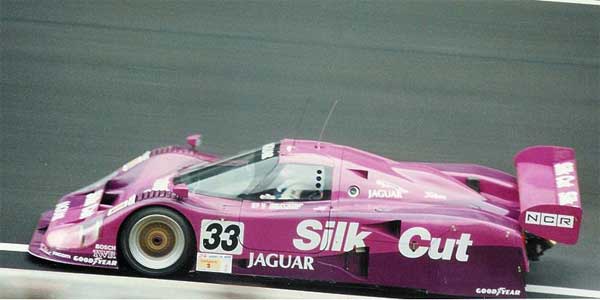|
|
32767 view(s)  After using the same basic chassis design for three years, TWR set about developing two brand new cars for 1989; the XJR-10 and XJR-11 for IMSA and Group C respectively. Both featured a turbocharged V6 engine of 3 and 3.5 litre displacement. The XJR-10 car was moderately successful, but with one victory the XJR-11 was not a worthy replacement for the XJR-9. Especially in long races, the V6 engine proved fragile and in 1990 the old V12 engine was brought back out for Le Mans. Enter the XJR -12 the final version of the Jaguar Group C 's After using the same basic chassis design for three years, TWR set about developing two brand new cars for 1989; the XJR-10 and XJR-11 for IMSA and Group C respectively. Both featured a turbocharged V6 engine of 3 and 3.5 litre displacement. The XJR-10 car was moderately successful, but with one victory the XJR-11 was not a worthy replacement for the XJR-9. Especially in long races, the V6 engine proved fragile and in 1990 the old V12 engine was brought back out for Le Mans. Enter the XJR -12 the final version of the Jaguar Group C 's
XJR 12 development
With the XJR 12 TWR set out to cure the glitches that had cost them so dearly 12 months earlier. Tyres turning on the rim, no problem, change from Dunlop to Goodyear. Gearbox causing problems, reinforce the bugger. Cracked exhausts due to excessive vibrations, redesign the manifold. 2 more chicanes and one less straight, adapt the aero package and powercurve of the V12 accordingly. One by one TWR looked a pragmatic solution for each of the problems encounterd in 89.
Besides an new livery and the Goodyear tyres, visible changes to the XJR 12 were found at the front, side and the rear.
Two Naca ducts on top of the hood fed air to the brakes, this relocation cleaned up the airflow of the front underbody. Big Naca ducts were also used in the side bodywork to feed the oil coolers. The recessed ducts less prone to damage in case of lateral contact. Finally at the rear a 2 element wing allowed more finetuning in extracting more flow of the redesigned diffuser.
1990 LM 24hrs
Due to the rift between FISA and ACO the 1990 edition of the Le Mans 24hrs did not count for the WSC. This did not stop the usual suspects from entering the race. With exception of Mercedes which , having scored their much wanted victory in 89, felt there was no gain in returning to a "non championship" event. But their loss of competition was easilly compensated by Nissan, Mazda and Toyota. Looking for that first Japanese win Nissan entered no less than 7 cars. And should those fail, there were still 19 Porsche's to take care off
Most of its competitors at LeMans ran turbocharged engines, and by turning up the boost could shine during the qualifications. for TWR using the proven naturally aspirated V12 engine there were no such qualification gains, so they concetrated on finding a good race pace and fuel economy.
Early in the race the turbo Nissans and Porsches fought for the lead with the four Jaguars keeping within striking distance. Over the night the turbocharged cars paid for their early speed and one by one started to retire, in the final hour the last Porsche blew up. This retirement saw the #3 and #2 Jaguar move up to first and second respectively.
Exactly 40 years after first competing at Le Mans in 1950, Jaguar scored its seventh victory in the classic endurance race in 1990. Martin Brundle,
Price Cobb and Denmark's John Nielsen celebrated an emotional win for the Coventry Team.
1991 LM 24hrs 
By 1991 the goalpost had shifted once again, Le Mans was back on the WSC calendar but this was to be the era of the 3,5l cars. As each of the contestants had to take part in every event Jaguar duely brought their XJR 14 to La Sarthe, if only to take pole. But due to unknowns in the development of the Cosworth HB engine, racing the "sprinter" over the full 24hrs was never an option. For this TWR relied once again on the by now "outdated" XJR 12.
Three XJR-12s were entered in the C2 class. Clad in the same swirling new livery as the WSC cars the final "12" still looked like it could, but the more stringent fuel and weight limitations were to big to overcome.
Although the XJR-12s did not manage to win, Jaguar's decision not to run the untested XJR-14 was vindicated by the fact that neither Peugeot's nor Sauber-Mercedes' 3.5 liter cars finished.
Dimensions of the Jaguar XJR 12 :
Lenght: 4760mm, Width: 2000mm, Height: 971mm, Wheelbase: 2730 mm
TWR Jaguar XJR - 12
1991 Technical Specification
Chassis
Monocoque, Kevlar / carbonfibre composites
Body Carbonfibre composites
Underbody composites flat bottom, two ground - effect venturi
Engine
Jaguar V12
Capacity: 7000cc
Cylinders: V12 at 60 deg, two valves per cylinder, water cooled
Ignition: TWR/Zytek
Power: 730 PS at 7000 rpm
Torque: 610lbs/ft at 5500 rpm
Weight: 240 kg
Transmission
TWR five-speed gearbox,
straight cut gears, four plate AP clutch
Suspension
Front: wide based wishbones actuating pushrods to horizontal coilspring/dampers
Rear: Magnesium uprights, vertical coilspring/dampers
Brakes
Ventilated Steel disks
Wheels
Front 17 in x 12 in
Rear 18 in x 14,5 in
Tyres
Goodyear Eagle
Weight
1000 kg
Sources:Wouter Melissen, www.ultimatecarpage.com , Wikipedia Jaguar XJR 9, 24 heures du Mans 1988, editions Acla
|
Models for Jaguar XJR 12
 |
| Manufacturer |
Model |
Scale |
Dimensions (LxWxH) |
Wheelbase |
Front spur |
Rear spur |
| Studio 27 |
#3 XJR-12 LM 1990 |
1/24 |
99.9x83.0x41.0 |
99.9 |
81.5 |
83.0 |
| Studio 27 |
#33 XJR-12 LM 1991 |
1/24 |
99.9x83.0x41.0 |
99.9 |
81.5 |
83.0 |
|

